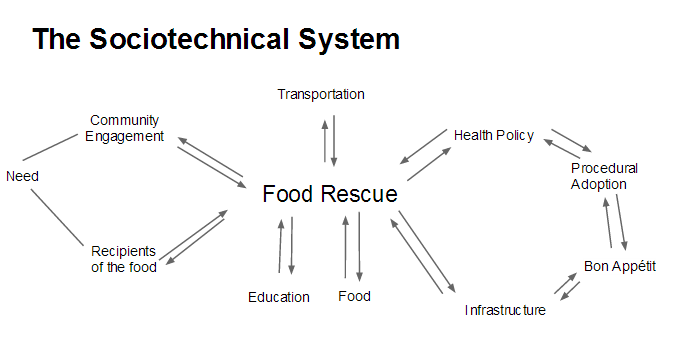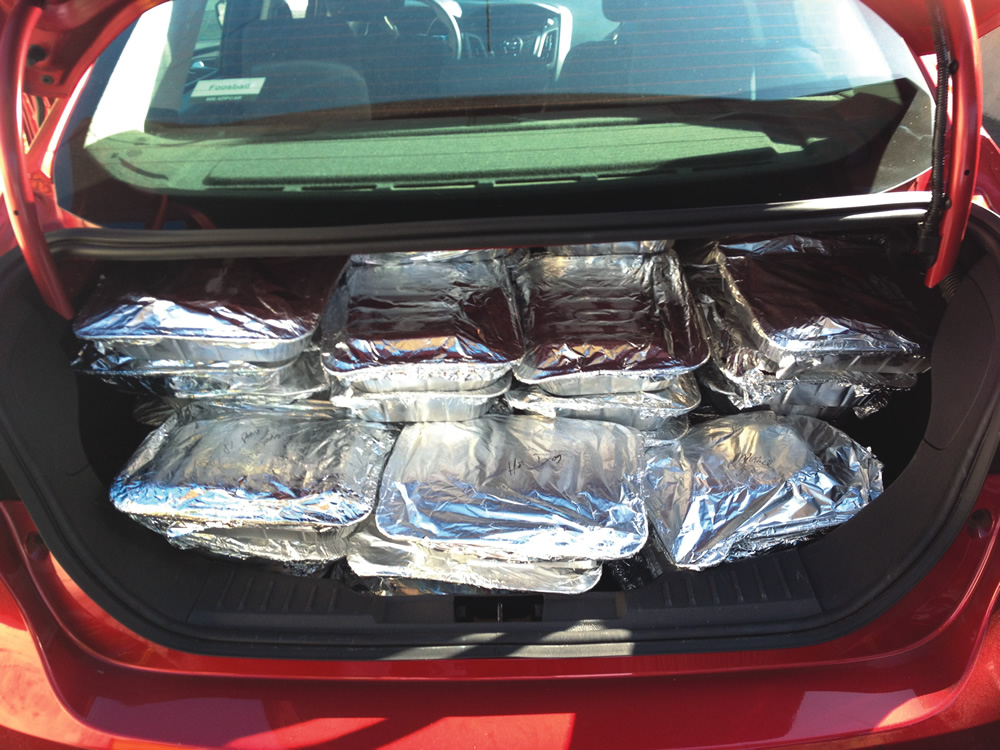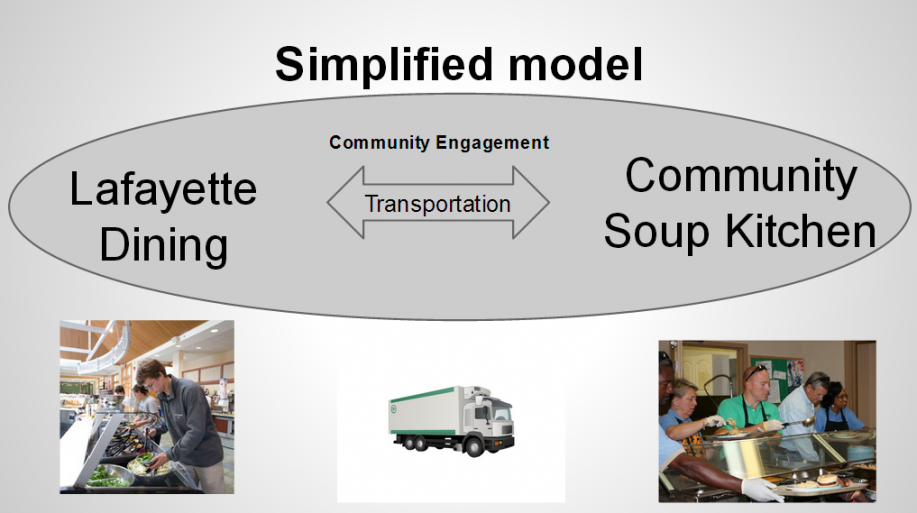Technical Analysis
A food rescue program involves the development of a interconnected system. The proper development and understanding of the different parts that are necessary in order to run a food rescue system is crucial to the success of the actual program. The way it is designed and executed will affect operation down the line. Food rescue is a great example of a system that is both technology dependent while having other aspects to it that are completely separate from technology. There are many different aspects of food recovery that are interconnected which all must be thought of and considered when developing a technical system for a food rescue program. Though a food rescue program at Lafayette College would be similar to a model at other colleges, it is imperative to consider Lafayette specific things (this would include the social, political, and economic contexts covered in the other sections.)
To understand how we designed our model for food rescue first we should look at the complex sociotechnical system we developed to better understand and answer our research question: What would it take to implement a food rescue program at Lafayette College?

As discussed in the Policy Analysis, there are four main stakeholders (Bon Appetit, Lafayette Students, the Easton Community, and a local food collection agency) falling under the main groups of Lafayette College and the Easton community. These stakeholders need to encompass these critical aspects in order for our technical system to work. In order to provide ourselves with a more feasible design model, we have simplified the model a bit giving a better picture of what needs to be accomplished in order for a Lafayette College food rescue program to be successful.
This model gives a visual representation of what a food rescue program would look like at Lafayette College. The system requires a direct connection from Lafayette Dining services to a community organization. This model depicts the reciprocal relationship between Lafayette College Dining and the Easton Community. Lafayette as the donor of the food is collaborating with the recipients of the Easton Community through community engagement. Although the food is physically moving from donor to recipient, in order for this model to be successful both parts of the model must be collaborative, which is why we chose to visually show the model in a circular shape with community engagement as the driving force. This visual representation emphasizes the connection and relationship of the parties within the model.
In a discussion with Claire Cummings, Waste Specialist at Bon Appétit Management Company, she described two types of systems which other Bon Appétit schools have utilized. One type of system is a student-run system and the other is a direct system. The student-run system would involve students running the point on the food recovery program. Bon Appétit has a developed relationship with the Food Recovery Network, which is an organization dedicated to developing these programs on colleges across the country. Students would package and transport the food to a local food agency which would distribute it to those in need. In a direct system, students are not involved. There is a direct partnership between the dining hall and the local food agency. Both systems are viable options, however being at a college with a student body as active and involved as Lafayette, we feel the best system for Lafayette would be a student-run system. This type of system would be valuable and rewarding to the students involved and would promote more community engagement, which is vital to the success of the program as indicated in our model.
In terms of Food Recovery Programs through Lafayette College, Bon Appétit as a franchise has over 100 corporate cafes that have established food recovery programs. Of those 100, 25 are college or universities that have implemented a student run/assisted program. The other type of program available has no student base and instead it is a direct relationship between the donor, Lafayette, and the organization(s) we choose to partner with. For the purposes of the program we are trying to develop, the future goal is for it to be student assisted and ran, although this could potentially change due to things like the school’s legal concerns and student interest.
The most feasible way to get a food rescue program started is to utilize Bon Appétit’s relationship with the Food Recovery Network to start a chapter at Lafayette College. In order for a chapter to be started there needs to be a student organization interested in taking on the project. There are two options for finding a student organization to take on this program. One, create a new organization. Creating a new organization through student government would be a feasible option for obtaining the necessary student support for this type of project. Lafayette College is an easy place to start a club and a list of all the different organizations already offered can be found here. The second way of optaining a student organization to manage or work on this initiative would be finding an existing club on campus to take on the task. Through the Landis Outreach Center there are a number of organizations with related interests that can be brought together to work on developing the food rescue program. Some of these organizations include Oxfam Hunger and Poverty Awareness, Meals @ Third Street, or Safe Harbor Homeless Shelter. A third option would be a combination of the creating an organization and finding existing organizations. This would be accomplished by creating an organization and then recruiting the help of existing organizations. Whichever method is used it will be imperative to have a student organization actively involved in the operation of the project for a food rescue system to work properly.
Part of developing the student organization can be done through the Food Recovery Network. As highlighted in our policy analysis, this organization has the resources, experience, and familiarity with Bon Appétit to help with the process. They offer full-time staff dedicated to provided resources to new and existing food recovery programs across the nation. For a Food Recovery Network chapter to run effectively, there needs to be a core goup of students (around 2-7). They also need a student to be the contact/point-person to communicate and collaborate with. It is ideal for this person to be actively involved in the project through the starting and implementation phases. For this reason, it is best that a sophomore or junior get involved with this project.
Other than a student group to run the food rescue program, it is important to find the proper recipient for the food. This search is not an easy decision as we must understand the social implications of our selection. The Second Harvest Food Bank services the Lehigh Valley area. However to service Easton we need to find the right location or combination of locations that has the ability to quickly distribute the rescued food. Janet Ney, Coordinator of Advocacy and Outreach for the Second Harvest Food Bank, provided us with these current locations for Easton hunger relief sites. She also mentioned the need for a soup kitchen in the West Ward of Easton, however that is another project within itself. The list provides many options however the most likely to be able to receive and distribute prepared goods are the Greater Shiloh Soup Kitchen and the Safe Harbor shelter. The other sites are food pantries which typically receive and distribute packaged foods. It is important to include the location of the food relief site in the planning and organizing of the food rescue program.
Logistics of the the program would be dependent on what our partner organization’s limits, capabilities, and needs are. In terms of finding non-profits or capable partners, the requirements by Bon Appétit would be an organization that has a kitchen, whose hours would coincide with delivery times of students schedules, and have capabilities of storage and transportation. The necessary storage for the partner would need to be approximately enough to store 100 pounds of food (approximated from Denison Case Study in Economic Context). This is about 20 trays of food. Refrigeration overnight would be required. Also freezing may be necessary depending on the number of people using the partner organization.
On Lafayette’s side, there are three technical components to consider: packaging, storage, and transportation. For packaging Bon Appétit’s current practices line up with the necessary packaging for a food rescue program including labeling and dating. Food at Lafayette that is stored or that has been donated in the past is always packaged under the same conditions and with the same requirements. They are labeled, dated, allergens if any are sometimes specified. Joel Blice noted that additional labor for packaging could be handled by 1 to 2 student volunteers. The food would need to be packaged into tranportable trays. There are two options hotel trays and reusable trays. Hotel trays are currently used by Bon Appétit when transporting trays due to the low initial cost and the fact that they are disposable. Reusable trays have a higher initial investment and require more labor for cleaning on Bon Appétit’s end. For this program to be truly sustainable an investment in reusable trays will be needed (see Economic Context). As for storage, all storage would take place in the walk-in refrigerators already in-use by Bon Appétit. Joel Blice said Lafayette would have the storage capacity to store excess food given a three day a week donation model. This way the food would only need to be stored 24 hours. Transportation could be done on the part of the partner organization depending on their labor force. However it is more likely that student’s would be involved in the transportation of the food. Lafayette College mini-vans would be used to transport the food to the partner organization. It would take one student volunteer and one mini-van to transport the projected amount of food. Below is an example of what the student volunteer schedule would look like.
Sunday:
9PM-10PM: 2 students packaging 
Monday:
9PM-10PM: 2 students packaging
Tuesday:
8AM-8:30AM: 1 student transporting
9PM-10PM: 2 students packaging
Wednesday:
9PM-10PM: 2 students packaging
Thursday:
8AM-8:30AM: 1 student transporting
9PM-10PM: 2 students packaging
Friday:
9PM-10PM: 2 students packaging
Saturday:
8AM-8:30AM: 1 student transporting
9PM-10PM: 2 students packaging
In terms of the kinds of food we would deliver, Lafayette has 6 facilities, 2 of which are larger buffet styled dinning halls. The other four are closer to retail with various grab and go options. We see the larger buffets dining halls as our main supplies of food. The types of food we can deliver is also dependent on what our partner organization is willing to take. Some of them might be willing to take only pre-packaged foods whiles other will accept prepared foods that have not been put out and have been kept under safe conditions.

